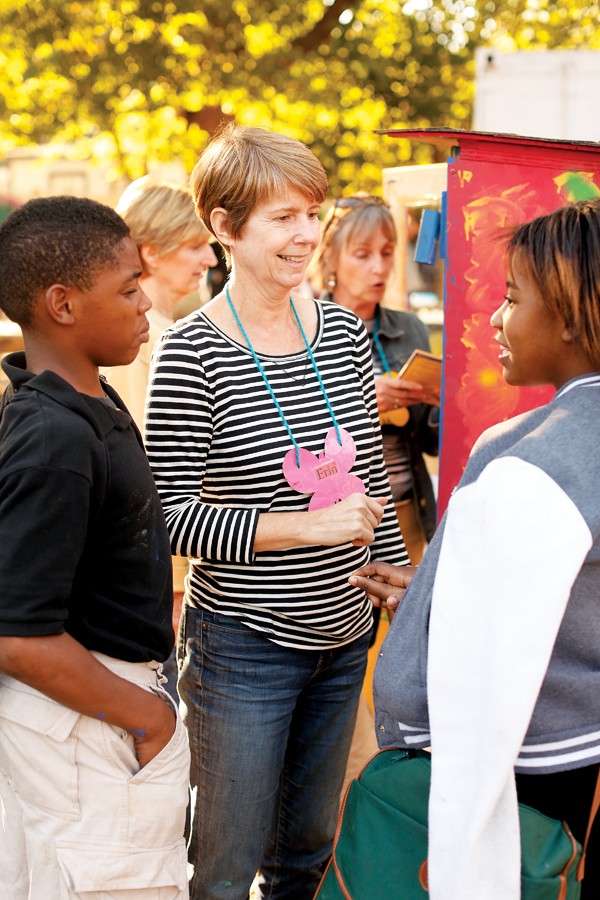 Justin Fox Burks
Justin Fox Burks
Erin Harris with kids at the Carpenter Art Garden in Binghampton
It’s 4 p.m. on a Tuesday afternoon, and about 40 elementary-age kids are working on art projects — some are painting pumpkins, others are adding mosaic tiles to a horse sculpture — in a once-blighted lot on Carpenter Street in Binghampton.
The lot that was once overgrown with weeds is now lined with colorful murals and dotted with planters made from discarded car tires painted all the shades of the rainbow. There’s a small stage for performers and picnic tables, where the kids are sitting.
 Justin Fox Burks
Justin Fox Burks
Welcome to the Carpenter Art Garden, a volunteer-run, after-school program that provides children of Binghampton with a creative outlet. They meet here weekly in the lot next door to a boarded-up purple house that’s spray-painted with the words “Property of the Memphis Police Organized Crime Unit.” It’s the perfect juxtaposition of what Binghampton was and what it’s becoming.
For years, Binghampton, bordered by Poplar, East Parkway, Summer, and Holmes, has suffered from blight, crime, poverty, and a perception problem. But thanks in part to the success of the neighborhood’s Broad Avenue Arts District, plans for the Hampline (a two-way bicycle lane through the neighborhood connecting with the Shelby Farms Greenline’s entrance on Tillman), and the work of the Mayor’s Innovation Delivery Team and Community L.I.F.T. (a neighborhood revitalization program that connects projects with funding sources), the area has been getting more positive attention from outsiders.
Meanwhile, groups within the neighborhood — the Binghampton Development Corporation (BDC), the Lester Community Center, Caritas Village, the Refugee Empowerment Program, etc. — have been working hard for years to clean up the blight, provide positive outlets for the residents, and take back the neighborhood without gentrifying or sacrificing its character.
Crime has gone down slightly, with 581 part-one crimes (assaults, burglaries, robberies, rapes, and the like) last year, versus 746 in 2002. And the blight is a little harder to find these days; the BDC has renovated 78 housing units in the past 10 years.
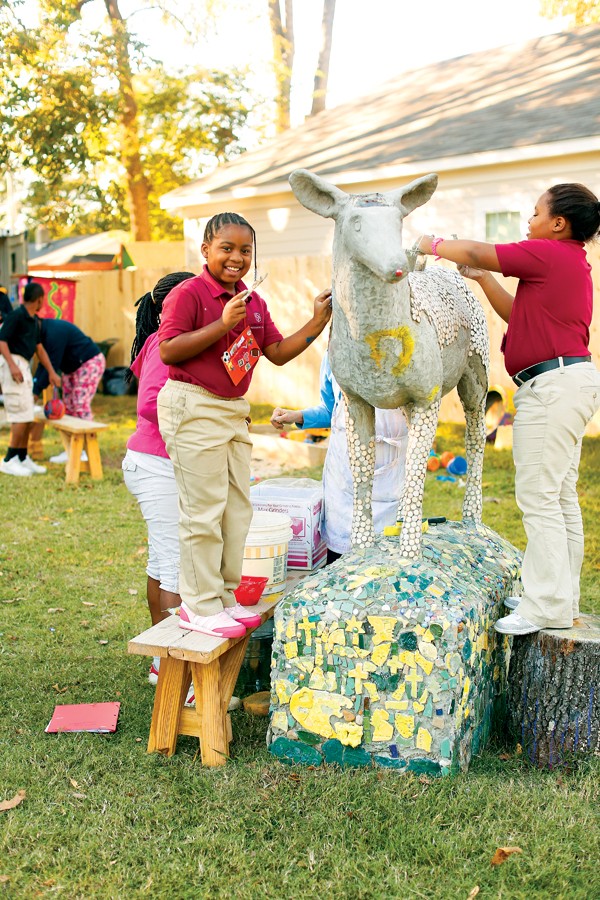 Justin Fox Burks
Justin Fox Burks
But if you ask Walter Casey, who has directed the Lester Community Center on Tillman for 33 years and grew up in the neighborhood, the biggest change isn’t something that can be measured in statistics.
“The biggest change I’ve seen is the attitude of the people. They come into the center now, and they’re really positive. They want more educational classes and family-oriented classes,” Casey says. “And I’ve seen the change when strangers are in the neighborhood, riding their bikes or walking or running. At one time, there was fear in their hearts. Now there’s no fear.”
Broad’s New Face
On a Saturday afternoon in early November, small groups lounge and sip from pint glasses of craft beer on the patio of Wiseacre Brewing Co., a new brewery and taproom in a restored warehouse just west of the railroad tracks that cross Broad Avenue.
A few blocks away, guitar aficionados sip wine at the grand opening of Guitar Spa, the latest installment of the Innovation Delivery Team’s MEMShop program. There, craftsman Kevin Ferner will build, sell, and restore custom guitars.
Throughout 2013, Mayor A C Wharton’s team has helped entrepreneurs open five pop-up retail shops and art galleries in once-vacant Broad properties. One more pop-up shop, a photography studio, will open before the year’s end.
“We give them free or reduced rent for the first six months to help them offset their start-up costs, and they receive business technical support from alt.Consulting,” says Abby Miller, project officer for the MEMShop program.
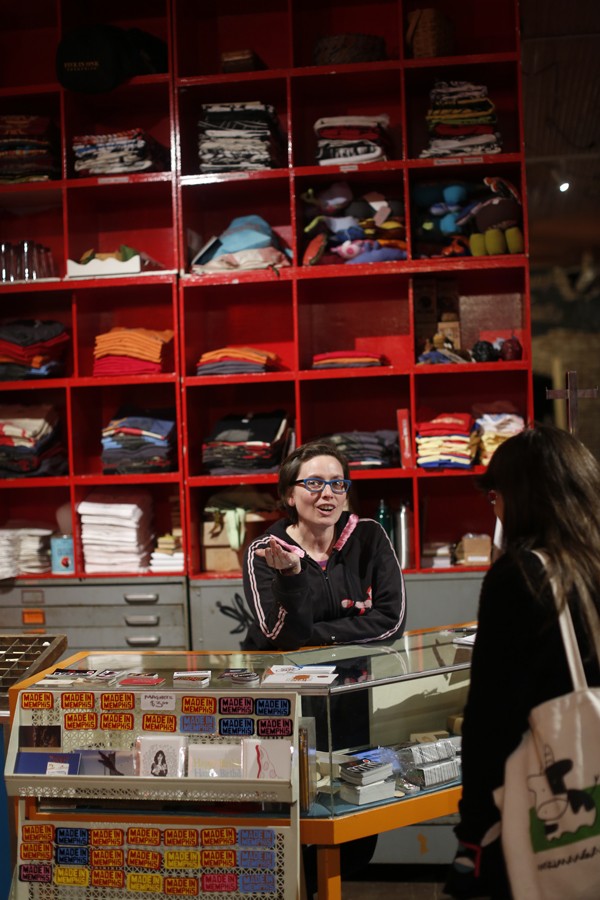 Justin Fox Burks
Justin Fox Burks
Alice Laskey-Castle at Five-in-One social club
Three of the five pop-up shops — Five-in-One Social Club (an art-class and retail space), My Heavenly Creations (purveyor of homemade bath and beauty products), and NJ Woods Gallery and Design (an art gallery) —have already signed long-term leases with intentions to operate on the street permanently. Another, Indie Style Market (seller of locally made crafts), is still working on its six-month MEMShop lease.
“We really love this space, and we’d wanted a storefront for a long time,” says Alice Laskey-Castle, co-owner of Five-in-One. She and partner Michael Andrews previously operated an art studio and social club in Crosstown. “I love that we have so many artists and craftspeople on the block. There’s a real energy to make Broad the place to go.”
The revitalization of Broad Avenue, once a ghost town of vacant storefronts, has been under way since about 2007, as artists and gallery owners began to relocate to the area with an eye on transforming the street into a thriving arts district.
David Wayne Brown, president of the Historic Broad Business Association and owner of advertising agency Splash Creative, moved his office into the area in 2007. He admits things were rough at first, but he’s seen a shift in crime along Broad.
“When I first moved in, we had two incidents where rocks were thrown into our front windows, and people broke in. But we haven’t had anything happen since. From talking to the Tillman police station, I know it’s absolutely true that crime has gone down,” Brown says.
The strip took off after the groundbreaking “New Face For an Old Broad” event in 2010, a two-day arts festival for which business owners created their own DIY bike lane.
Today, there are only a few vacant spaces left on Broad. The Cove, Jack Magoo’s Sports Bar & Grill, Three Angels Diner, and Broadway Pizza provide the nightlife and dining scene, while galleries and art studios such as T Clifton Gallery and Found host art openings and events. Tattoo artist Babak Tabatabai is preparing to open his shop, Ronin Design and Manufacturing, soon, and Muddy’s Bake Shop uses a Broad storefront for extra kitchen space to bake cupcakes.
Last November, Marcellus Harper opened Collage Dance Collective, a dance school aimed at teaching ballet to children of every income level, in a vacant warehouse space on Broad. Harper’s students come from all over the city, but a few come from the residential area of Binghampton located a few blocks away.
“We have students who walk here from the neighborhood, and we want to increase those numbers,” Harper says.
The Historic Broad Business Association hosts seasonal art-walk events, with the latest one scheduled for Friday, November 8th. More than 70 artists will be exhibiting at 30 locations along the street. The Mighty Souls Brass Band and the Collage Dance Corps will perform on the dock of the warehouse across from the commercial strip.
In a matter of months, that dock will be transformed into an amphitheater for live performances, thanks to a grant by ArtPlace America.
The UrbanArt Commission has placed a call to artists, ending November 8th, to create an art installation on Broad’s iconic water tower. And a crowd-sourced fund-raising campaign, through IOBY.org (IOBY stands for “in our backyards”), has been launched to raise $50,000 toward the $4.4 million Hampline bike lane. As of press time, $27,000 had been raised at ioby.org/project/hampline.
Construction is planned to begin late next summer on the Hampline, the city’s first two-way bicycle track, which will connect Overton Park to the Shelby Farms Greenline on Tillman. Once complete, the bike lane will be buffered from traffic with medians.
 Justin Fox Burks
Justin Fox Burks
Tom Clifton, Pat Brown, and Argus at T Clifton Gallery
“We’re excited that it will break down the perceptions of Binghampton,” says Pat Brown, co-owner of T Clifton Gallery and vice president of the Historic Broad Business Association. “There are families living on Tillman, and we’re excited that people from outside the neighborhood will better get to know that part of Binghampton.”
Taking on Tillman
The Hampline will turn south at Tillman Street from Broad, taking cyclists through one of the main arteries of residential Binghampton, a street once characterized by blighted apartment projects and a dangerous reputation.
 Justin Fox Burks
Justin Fox Burks
Kitty Woodland
It’ll go right past the Tillman Street apartment of Kitty Woodland, a spunky senior with long, bleach-blond hair. Woodland has lived in Binghampton for 60 years, and she’s seen the area change from good to worse to good again.
“It used to be so quiet, and everybody knew each other. We didn’t hardly have no violence or nothing going on. But a lot of people moved away. Ain’t too many people my age still around here,” Woodland says.
Though the area went through a rough patch a decade or so ago, Woodland says she sees things changing, thanks in part, she says, to the blight removal work of the BDC, which celebrated 10 years in 2013.
“They [the BDC] came to my house and did some work in 2007, because the house was so old. We didn’t even have lights in the ceiling. We just had lamps. But they came through and fixed the roof and wired my house with lights,” Woodland says.
Woodland’s house is near a new youth football field called the Hamp. The BDC purchased and demolished an aging apartment complex to make way for the field. Volunteer coaches from Memphis Gridiron Ministries organized a football team, the Binghampton Bulldogs, which kicked off its first season last summer.
 Justin Fox Burks
Justin Fox Burks
Wade West (top row, second from left) of Memphis Gridiron Ministries and his players and coaches
On a recent Tuesday afternoon, about 40 third- and fourth-graders from Binghampton posed for pictures in football uniforms donated by Nike. They took a few serious shots before the photographer said, “Do a goofy face.” The energetic boys giggled as they stuck out tongues and threw peace signs. As soon as the session was over, they broke up and started running chaotically around the field.
“Many of the teams we play are from suburban, private schools, so we are bringing suburban Memphis into urban Memphis and urban Memphis into the suburbs,” says Wade West, founder of Memphis Gridiron Ministries. “One of the biggest problems in our city is the lack of understanding between the black population and the white population. We’re trying to change that mindset.”

In its 10 years, the BDC, led by Robert Montague, has invested $10 million in property improvements and programs like the Hamp field. They’ve renovated 78 housing units, sold 31 properties, with seven additional lease-purchase deals, and constructed 14 new homes with the help of Binghampton residents, who learn construction skills.
“When I give a tour of the neighborhood now, it’s harder to find the abject blight. It’s still here, but it used to be pervasive,” Montague says. “Some of the arteries had the most hideous properties. Our strategy is to go after the worst and most impactful. Tillman is a big artery, so we went after some big apartment deals there.”
Last year, the BDC gave the Tillman Crossing complex, which overlooks the Greenline’s entrance, a makeover with fresh paint and renovated apartments. When the Greenline first opened, critics complained about the graffiti-stained, abandoned complex. Now it’s full of tenants, including the Greenline ranger office.
Across the street from the Greenline, the BDC cleaned up an overgrown lot and installed a public park.
But the BDC’s work extends beyond Tillman. Deep inside Binghampton on Carpenter Street, they assisted former art teacher Erin Harris in purchasing and cleaning up the overgrown lot that now serves as the Carpenter Art Garden.
“This offers kids the art they’re not getting in school, but more importantly, they’ve all become much better friends,” Harris says. “They’re like a little family now. We’ve had kids whose parents want to move out of the neighborhood, and the kids say no. They don’t want to leave the community of the garden.”
The kids and Harris’ team of volunteers have taken their art beyond the garden in recent weeks, painting colorful murals on the sides of businesses along Tillman.
Harris is working with the BDC to acquire and rehab the purple boarded-up house next door and turn it into an art studio and computer lab. A few plots down, she also worked with the BDC to create a community garden.
Additionally, the Mayor’s Innovation Delivery Team and Community L.I.F.T. have turned their attention to Tillman. They recently pushed the Inner-City Economic Development initiative, which provides forgivable loans to Binghampton business owners to make improvements to their storefronts, through the Memphis City Council.
Sonda Chapman, owner of the Timesaver III convenience store on Tillman, is hoping to be approved for one of those loans.
“I should try and get my parking lot fixed. It’s raggedy. I’d also like to fix up one of the [vacant] buildings next door so I can rent it out,” Chapman says.
The West Village
Due to barriers like Sam Cooper Boulevard and a set of railroad tracks cutting through the neighborhood, Binghampton is essentially split into separate communities.
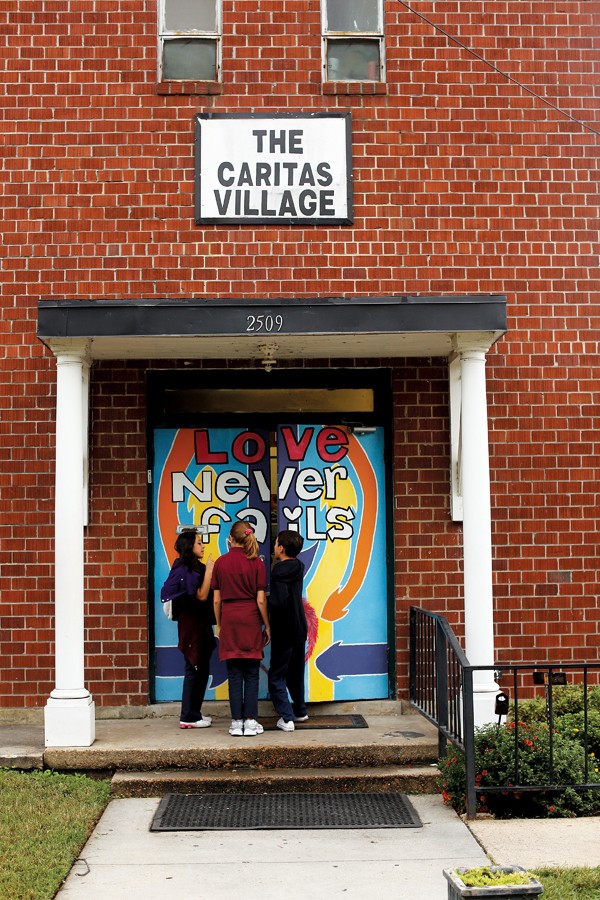
The Caritas Village in Binghampton offers multiple programs for the residents
Nothing exemplifies the west side, between East Parkway and Collins, better than the Caritas Village, a nonprofit coffee shop and cultural center that aims to “break down walls of hostility and build bridges of love and trust between the rich and those made poor,” according to founder Onie Johns.
Each day, Caritas Village offers programs ranging from art and dance classes and poetry readings to Bible study and yoga. There’s a free medical clinic for Binghampton residents on Tuesdays. Many of the programs are aimed at the area’s large Hispanic population.
They also serve coffee and breakfast in the morning and burgers and sandwiches at lunch every day, attracting diners from across the city.
Johns, who last month received the AARP’s most prestigious volunteer award, moved from Germantown to Binghampton in 2000, after she says she received a religious calling to work in an inner-city neighborhood.
“Back then, my best friend said she couldn’t come see me in this neighborhood because she was afraid to bring her car into the area,” Johns says.
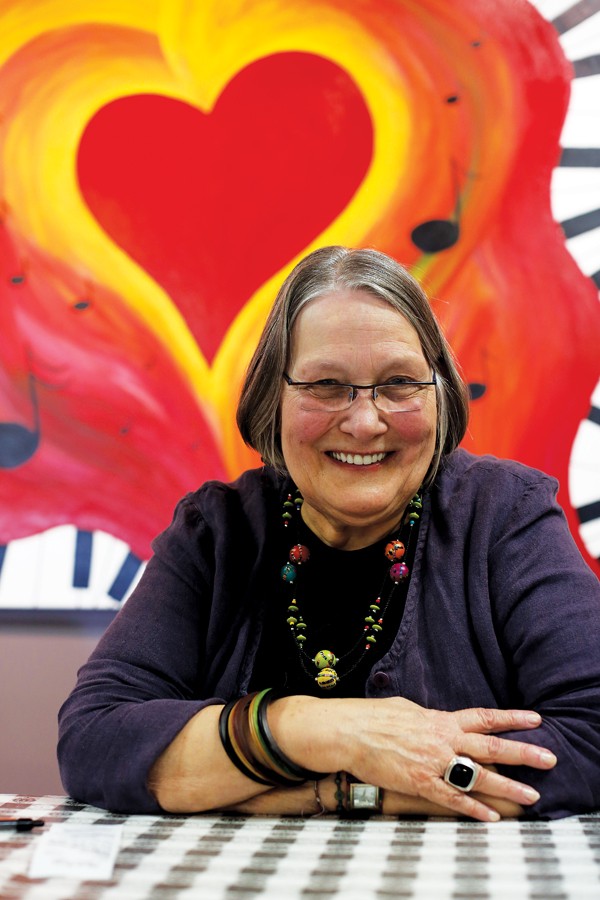
Onie Johns, Caritas Village founder
Johns admits that even she was unsure what she’d face once she moved her life to Binghampton.
“It’s not near as scary when you get to know the area. When I used to drive in from Germantown, I thought it was the most deprived area I’d ever seen. Now I sleep here every night,” Johns says.
A few blocks away, Amy Moritz runs the Center for Transforming Communities, a collection of nonprofits that includes homeless service provider Door of Hope, the McMerton Community Gardens, Binghampton United Methodist Church, and Holy Pentecost Church (where refugees from the African country of Burundi hold services in their native language).
“I have some distinct memories early on in my tenure here of people meeting me for service work on the building and saying, ‘Aren’t you afraid to work here?'” Moritz says. “But this is a positive place with positive energy.”
One of the programs at the center, the Refugee Empowerment Program, provides educational classes to Binghampton’s large refugee population. People from 18 countries, including Somalia, Sudan, Ethiopia, Iraq, and Burma, take English as a Second Language courses there.
Anthony Gilbert, a violinist, rents studio space at the Center for Transforming Communities and lives in the community as well. He moved to Binghampton in 2011, attracted by inexpensive rent and diversity.
“As an artist, I can live so cheaply here, which is great for my music. My rent is less than some people’s bills at Whole Foods,” Gilbert says. “I don’t have to work 40 hours a week or have another job. I can just hustle and play my gigs.”
Gilbert teaches affordable violin lessons to Binghampton residents, and he has visions of starting a music school at the center.
Johns admits that plenty of work still needs to be done to improve the lives of many of Binghampton’s low-income residents. But through her work, she sees the community becoming stronger as more people begin to work together.
“It’s so rich with relationships that you forget the deprivation that is here,” Johns says.
Broad Effects
Although community activists such as Johns and Montague with the BDC have been working in Binghampton for years, outsiders’ perceptions of the area as dangerous have only recently begun to shift.
While numerous factors come into play, the fact that cyclists and joggers now must cross Tillman to access the Greenline entrance has likely played a big part in breaking down barriers. Art events on Broad that attract people from all over the city have also played a role in the larger Memphis community embracing Binghampton.
“So many people came to ‘New Face For an Old Broad’ [in 2010] because they knew what a terrible reputation Broad had, and they were curious as to what the hell we were doing,” says Tom Clifton of T Clifton Gallery.
“Now they feel like they’re a part of it and are partially responsible, and that bleeds over into Binghampton as a whole. They want the whole area to succeed because of what they’ve seen happen on Broad.”
Pat Brown of T Clifton admits there’s work to be done in bridging the gap between Broad and the residential neighborhood south of Sam Cooper Boulevard. She says they’re trying to get more Binghampton residents to utilize the services and visit art events along the street.
“A large percentage of Binghampton residents are pedestrians, and Sam Cooper is a barrier to some. But we realize to be successful, we have to engage the community,” she says.
Over the past several months, the Mayor’s Innovation Delivery Team has held monthly Night Market events, where artists and craftspeople peddle their wares in a parking lot on Broad. The Historic Broad Business Association has held focus groups before the markets, making sure to include the residents, inviting them to be vendors.
Johns, who offers art programs at Caritas, knows firsthand that it can be difficult to get residents interested in art.
“For the people in the neighborhood who are struggling to get by, art is just not their thing,” Johns says. “When we first started doing art workshops here with the kids, it was really difficult to get them to come.”
But Montague says that attitude is slowly changing.
“The early art walks were more homogenous and not of the neighborhood, but the last art walk was extremely diverse,” Montague says. “I hope more and more Binghampton folks physically connect on Broad — eat there, shop there, go to the stage on the loading dock. I think the amphitheater [on the warehouse loading dock] will draw more people there.
“There were tumbleweeds going down Broad when we got here 10 years ago, and there was prostitution and gambling,” Montague continues. “Broad has had an indirect, very positive effect on the people of Binghampton.”
 Caritas Village/Facebook
Caritas Village/Facebook  Caritas Village/Facebook
Caritas Village/Facebook 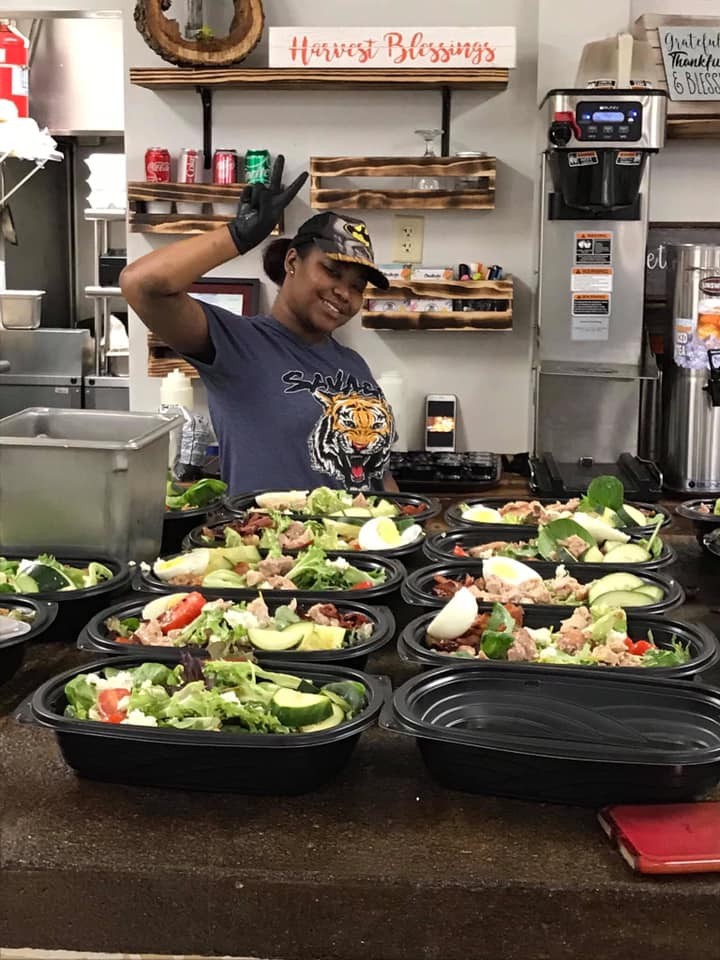 Caritas Village/Facebook
Caritas Village/Facebook  Photographs by Justin Fox Burks
Photographs by Justin Fox Burks 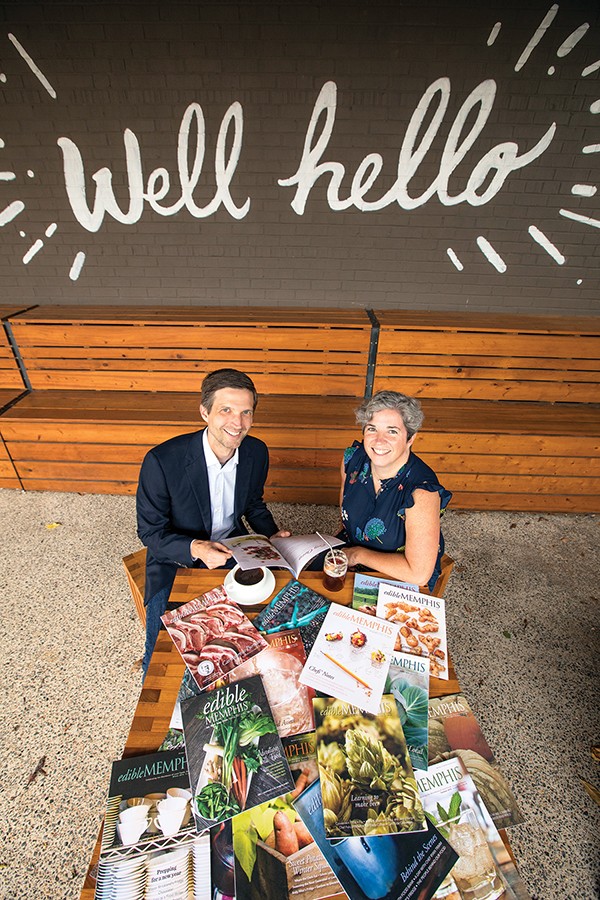


 Photographs by Justin Fox Burks
Photographs by Justin Fox Burks 

 Michael Gray | Dreamstime.com
Michael Gray | Dreamstime.com 
 Justin Fox Burks
Justin Fox Burks  Justin Fox Burks
Justin Fox Burks  Justin Fox Burks
Justin Fox Burks  Justin Fox Burks
Justin Fox Burks  Justin Fox Burks
Justin Fox Burks  Justin Fox Burks
Justin Fox Burks  Justin Fox Burks
Justin Fox Burks 

